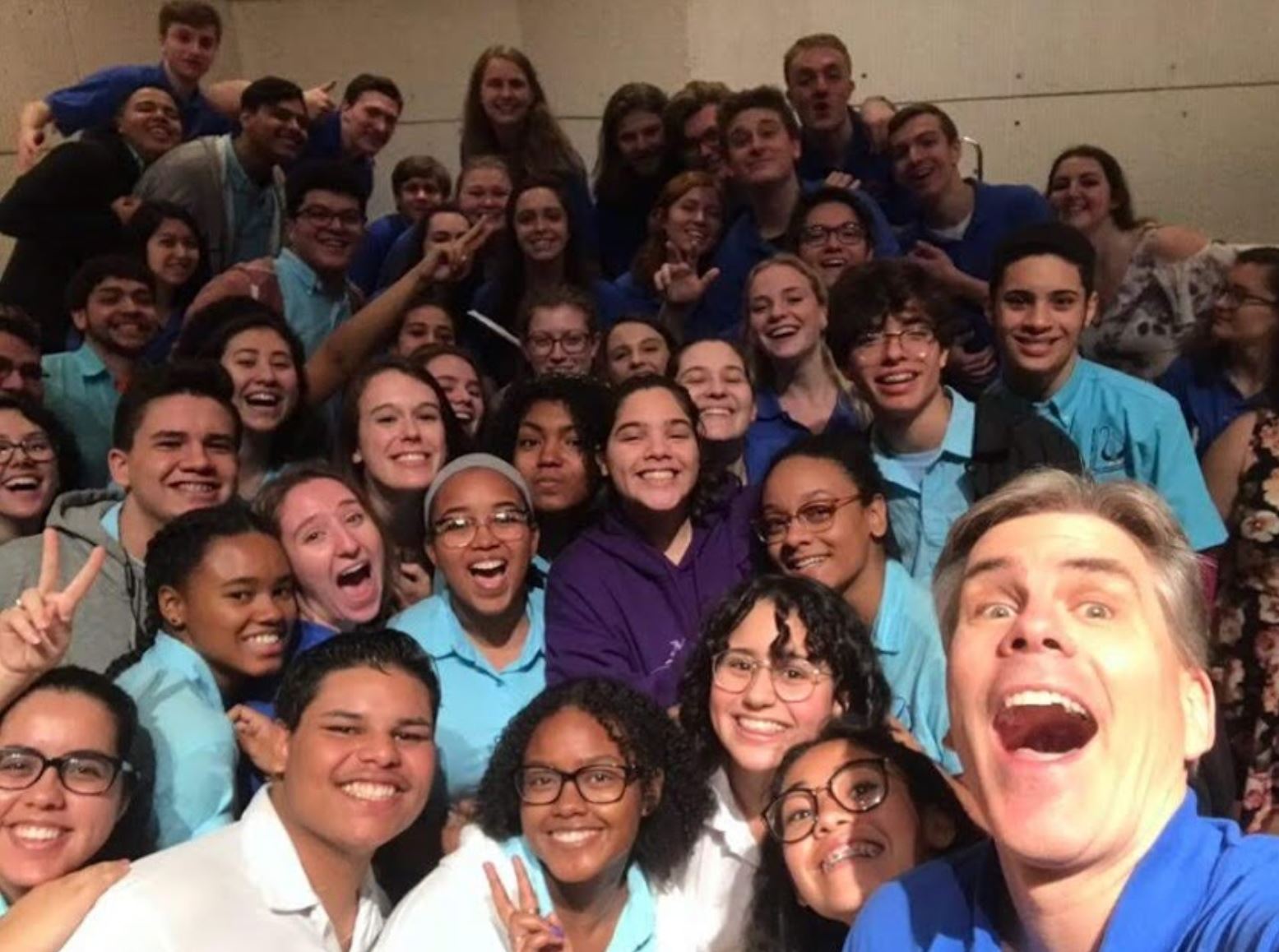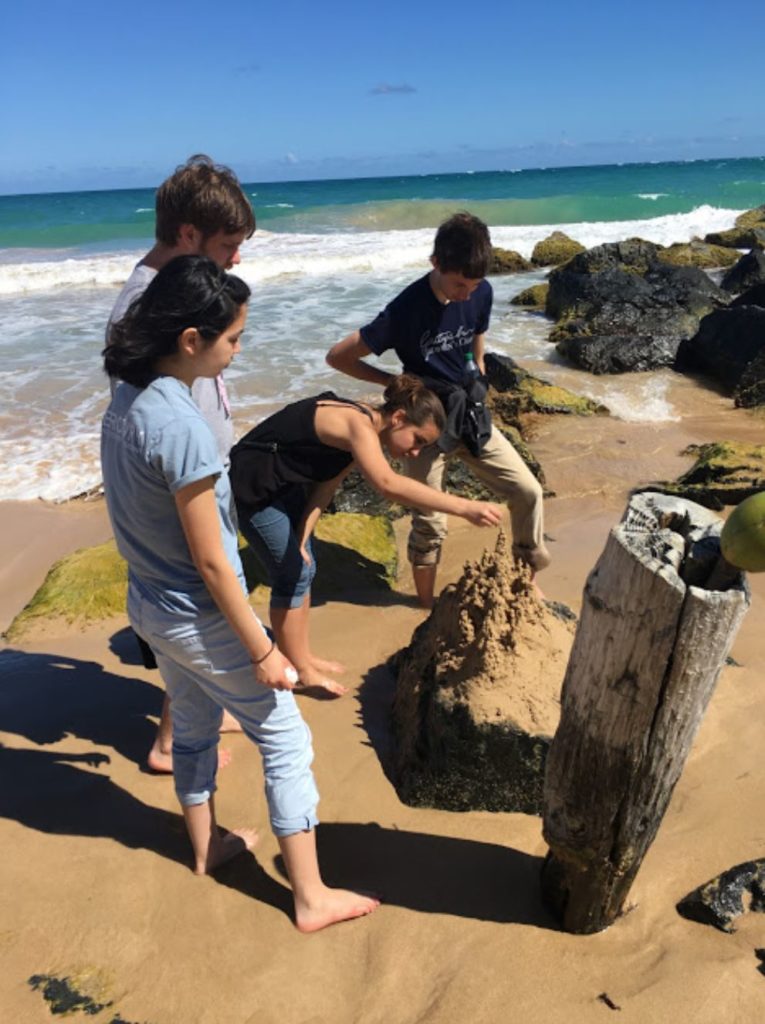
Dr. Robert Natter cheeses with students from both the Gettysburg and Puerto Rican choir at Escuela Libre de Música (Photo courtesy of Gettysburg College Choir)
By Julia Chin, Staff Writer
It’s 4:45 AM on a Saturday and the first day of Gettysburg College’s spring break is quiet, save for a stirring on the second floor of Schmucker Hall. In Choir Director Dr. Robert Natter’s office, there is a cardboard box flocked by students. Winter coats and dorm keys are dropped into the box without a second glance: these are items the Gettysburg College Choir will not need where they’re headed.
A few hours later, their plane touches down amidst a tropical landscape of palm trees and blazing sunshine, and most of the choir begins to pull out sunglasses and Spanish phrases in anticipation of warm sand between their toes. Hola, Puerto Rico.
In the Gettysburg College Choir, there is no such thing as a spring break without song. The choir tours for the week-long academic break each year, usually travelling by bus through the states with concert stops and homestays along the way.
However, from March 10-16, the vocal ensemble took flight and travelled the extra miles, as they do every four years, to their 2019 tour destination: Puerto Rico. As a sophomore, I am wrapping up my second year in College Choir and can’t begin to describe how grateful I am for this past week, an unforgettable experience I’ll always cherish.
As soon as we dropped our luggage off at the hotel in Condado, we sought the sea like crabs scuttling to water. If I had to associate tour with one memory, it would be of the ocean: blue, infinite, and constant. From our first afternoon on the island, every land-locked Gettysburgian fell in love with those depths of clear aquamarine.
This passion for the sea is reflected in the hallmark piece of our concert repertoire, “La Puerta Intima,” an original collection of songs commissioned by the Gettysburg College Choir. This composition by former alumnus and chorister Matt Carlson ‘13 was set to three poems by Puerto Rican writer and social rights activist Julia De Burgos, entitled “Amaneceres,” “Almamarina,” and “Mar.” In English, they translate to “Dawnings,” “Seasoul,” and “Sea,” respectively. De Burgos’ poetry sweeps over a vast range of feelings, reflecting upon dawnings in the poet’s soul as she bursts with a million proletariat hymns as well as the incredibly strong allure of the sea and its livid blue hue.

Hannah Kolarik ’20, Vanessa Case ’19, and Ben Fruchtl ’20 rush to the sea as soon as possible (Photo courtest of Gettysburg College Choir)
Only hours after stepping off the plane, we held our first concert and the world premiere of these ocean-inspired pieces at the Iglesia San Francisco de Asis, a Catholic church with an appropriately-colored pastel turquoise interior. In addition to Choir Director Dr. Robert Natter and Coordinator of Music Education Dr. Brent Talbot, the new director of the Sunderman Conservatory, Dr. James Day, accompanied the choir on our Puerto Rican adventure. A professional guitarist, Day provided the simultaneously lilting and inspiring guitar melodies that Carlson’s pieces called for.
While we had come to the island to make music as a choir, we were also there to educate ourselves on Puerto Rico as a cultural community. Though Puerto Rico is a U.S. commonwealth, we soon discovered a culture so rich and distinctive that it felt like a different country.
The immersive nature of this year’s choir tour was largely due to the selected concert venues. Because a significant majority of Puerto Ricans identify as Roman Catholic, the choir often attended Mass in Spanish at churches like St. Francis before following the worship service with a concert for the congregation.
Even those of us who had been to Catholic Mass in the States were quick to distinguish Latin American influences in the style of these cathedrals and chapels, often ornately decorated and featuring a variety of icons and stunning architecture. Yet, no matter how simple or embellished they were, each sacred space exuded an almost tangible atmosphere of reverence and tradition.
Aside from churches, the choir also sang at a handful of Puerto Rican schools in “cultural exchange” concerts with their choirs. We would sing some songs for them, they would sing some songs for us, and sometimes we’d even sing together!
At each of the three schools we visited—Ponce High School, Escuela Especializada de Bellas Artes de Bayamón, and Escuela Libre de Música—we were amazed by the level of musicianship and passion for singing the students exhibited. From traditional Puerto Rican songs in Spanish to English showtunes from Hamilton and The Greatest Showman, the youth choirs all gave amazing performances worthy of standing ovations.
The gratitude was mutual, as all of these students seemed so genuinely happy to receive us in their homeland. As we were singing, they smiled and applauded for us; one girl in the front row even kept her hand over her heart throughout our whole set to convey her admiration.
After every cultural exchange concert, we always chatted with the students, often breaking into song and laughing together with our newfound friends. I’ll never forget one sophomore named Nicole, who had a long conversation with us and gushed about how thrilled she was that we were there. We talked about choir, life, and musicals; after half an hour, Nicole felt like an old friend.
Often, our itinerary got slightly delayed because of how engaged students from both choirs were with one another: no one wanted to say goodbye! After leaving Bellas Artes, one member of our choir immediately received a snapchat from several of the school’s students with the caption “We miss you already!”
I feel that I speak for all of the Gettysburg College Choir in saying that we are so grateful to have participated in such a heart-warming and music-making bridging of cultures with these exemplary youth. We, too certainly miss them already!
Besides making new friends and receiving occasional language lessons from our resident Spanish major Caitie Glance ‘20, College Choir found Puerto Rican culture in the area’s brightly colored buildings of San Juan, fried snacks at a fritter stand, and the rhythms of a bomba drum.

Vanessa Case ’19, Brian Buechele ’22, Olivia Benson ’19, Zach De Besche ’22, Eric Gabriel ’22, and Caitie Glance ’20 sport their new turbans in the style of traditional Puerto Rican headdress (Photo courtesy of Gettysburg College Choir)
With the three professor supervisors heading the trip, our headcount totalled 36 Gettysburgians in Puerto Rico; however, we’ll never forget our lucky number 37, Hector Arizmendi Laguer. An archaeology student at the Universidad de Puerto Rico Carolina, Laguer served as the choir’s tour guide through the streets of Old San Juan, Ponce, and Loíza for the entirety of our tour. He told us about the mythological gods of the rainforest, the best coffee shop in the old city, and the origins of different Puerto Rican dance rhythms.
We learned that much of Puerto Rico’s melting pot came from three major cultural influences: the indigenous Taino, the Africans, and the Spanish, each with a key presence in certain areas and city art sculptures. Some other highlights of the trip included a traditional Bomba dance class, a Catamaran cruise and snorkeling in the Caribbean sea, and of course, the food. Tostones, guava, and congri all became part of our basic diet, but there were absolutely no complaints there, especially when flan came around for dessert just about every night. Sweet, savory, and salty, nothing could beat the taste of Puerto Rico!
However, truly understanding Puerto Rican culture isn’t just about the light but also the dark. After Hurricane Maria, the island had a detrimental lack of tourism in the following year as many businesses were closed down.
During our stay, we were able to attend a few presentations given by nonprofit microlender companies as well as working-class citizens. Through their voices, we gained a perspective and insight into the ways that people are still trying to rebuild their homes and livelihoods after such a shocking natural disaster nearly a year later. It was truly miraculous to hear the story of how one woman’s schoolhouse barely survived the hurricane, yet she still refused to give up hope. As she and her colleagues rebuilt the classrooms, students came back within two weeks and began to provide hope for a future community.

Julia Chin ’21, Ethan Fielding ’22, Brittney Sedgwick ‘ 21, and Ben Fruchtl ’20 say their goodbyes to the ocean with a sand castle on the last morning of tour (Photo courtesy of Gettysburg College Choir)
The last concert was held in a local church on Friday night, with a humble audience of four, but we wouldn’t have had it any other way. The intimate space seemed perfect, reflecting those individual interactions and personal connections we had made along our journey that week.
Everyone was feeling bittersweet with sad smiles as Dr. Natter gratefully thanked each of our attendees and asked them their names before the concert began. It may have been our best performance yet, proving that music is something that blossoms within us, not dictated by audience or venue.
At the end, a woman named Cherry thanked the choir for the music we created and told us that we would always be welcomed to Puerto Rico, our home as well as hers. Her words inspired a lot of choir members, who, already emotional within the context of this final concert, teared up during the subsequent encore of “La Borinqueña,” the Puerto Rican national anthem. It was a moment none of us will ever forget.
Ultimately, the time came to leave Borinquen behind, as well as the sea, sand, and sun. Back in Gettysburg now, most of the choir has lamented about how they’d give anything go back and have another meal of rice and beans.
Though we were all saddened to leave behind our second home in San Juan, we are looking forward to the finale of our tour journey this weekend. At 8:00 p.m. on Saturday, March 23, the College Choir will be performing the Puerto Rican Tour repertoire at their Home Concert in Christ Chapel and saying one final farewell to the sea. Though we are no longer with the land we have come to know as “the daughter of the sea and sun,” we preserve her memory in this final chapter of our tour.
Muchas gracias, Puerto Rico. You will always be in our hearts.
More firsthand details and photographs of our adventures can be found on a forum for online blog postings created by several members of the Gettysburg College Choir during their 2019 tour.
